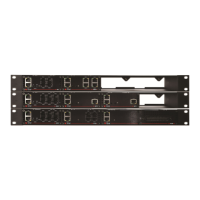QX50/QX200/QX2000; (SW Version 6.0.x) 107
QX50/QX200/QX2000 Manual II: Administrator’s Guide
For example, if an extension is not assigned to a certain class of service and an attempt is made to place a call from that extension using routing rule with
the Class of Service enabled, then “Number dialed does not exist” message will be played to the caller.
The permissions for a group of PBX extensions can be changed easily by modifying the CoS variable for each PBX extension.
On QX IP PBX the defined CoS variables are associated with PBX/Conference extensions and call routing rules in the Call Routing Table.
In order to configure CoS feature, follow the steps below:
• At first assign the specified CoS(s) to a certain routing rule(s).
• Assign the specified CoS(s) to the PBX/Conference extension(s).
If there is no CoS assigned to the call routing rule, that rule will be generally available for any PBX extension whether it is attached to a CoS or not.
Please Note: If the Enable Class of Service option is disabled, call routing rule(s) that are assigned to a certain CoS(s) will be available for any PBX
extension, if there are no any other filtering limitations.
Class of Service
page offers the following components:
Enable Class of Service checkbox is used to enable the Class of
Service functionality on the QX IP PBX and consists of the
following components:
Add opens the Class of Services - Add Entry page where a
new class of service can be created.
Edit opens the Class of Services - Edit Entry page where the
selected class of service’s settings can be modified. This page
includes the same components as the Class of Services - Add
Entry page does.
Fig.II- 154: Class of Services page
The Go to Extensions Management link leads to the Extensions Management page where the extensions can be assigned to use certain class of service from
the Extensions Management – Edit Entry – Class of Service Settings page.
The
Go to Conferences Management link appears only if the Conference feature is activated from the Feature Keys page and leads to the Conferences
Management page where the conference extensions can be assigned to use certain class of service.
The
Go to Call Routing Table link leads to the Call Routing Table page where the call routing rules can be assigned to a certain class of service.
The Class of Service – Add Entry page is used to create a new Class of Service and contains the following components:
• Name
text field indicates the name of the class of
service. This name will be visible in the
Extensions Management – Class of Service
Settings page, in the Conferences Management –
Class of Service Settings page and in the Call
Routing Wizard when assigning the classes for
the extensions.
• Description
text field requires optional
information about the Class of Service.
Fig. II-1: Class of Services - Add Entry page
Call Recording Settings
The Call Recording service is optional on the QX IP PBX and is activated from Feature page by inserting a feature key.
The Call Recording is used to record PBX, SIP or PSTN calls on the QX IP PBX and store the recorded calls either in the local Recording Box or upload them
to the remote server. From Call Recording Settings page the call recording can be configured to be started automatically once the call starts or to be
started manually from
Administrator’s Main Page of the QX IP PBX's Web Management or by pressing the Record button on the IP phone during the call. If
no such button exists on IP phone, the functional key can be configured from QX IP PBX to handle the recording functionality (see
Programmable Keys
Configuration).
To configure Call Recording, an extension of the Recording Box type should be created first. The memory allocated to that extension will be used for
storing the recorded calls. There are two ways to access the recorded calls in the Recording Box: through handset and through Web Management. Through





